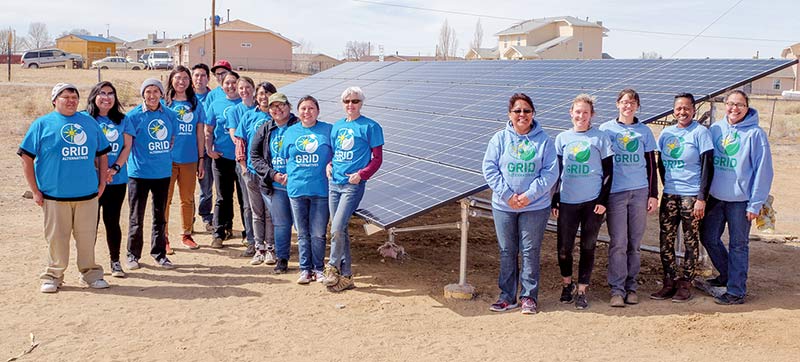
Giving back to the grid

Special to the Times | Ray Landry Ft. Lewis College students and faculty, left, and Grid Alternative staff, right, pose in front of newly constructed solar panels for Ojo Encino Chapter House.
Eastern chapter gets grid-tied solar array

Special to the Times | Ray Landry
Ft. Lewis College students and faculty, left, and Grid Alternative staff, right, pose in front of newly constructed solar panels for Ojo Encino Chapter House.
OJO ENCINO, N.M.
Crisscrossed by gas and oil pipelines, shaken by the heavy trucks motoring to and from the Bisti oil field, tiny Ojo Encino Chapter has long felt the effects of the extractive energy industry.
But as for its own electricity, the chapter house just made a major commitment to renewables.
On March 8, 11 college students, two professors, a handful of solar experts from the nonprofit Grid Alternatives, and chapter officials crowded around the chapter’s electric meter, cell phones in hand, holding their collective breath.
They powered up the big new solar array they had just installed, and — sure enough — the meter started spinning backwards.
Although they knew it would – or at least they were pretty sure – it was still “inspiring,” said Trujill Sandman, one of the 11 Diné students from Fort Lewis College who had given up their spring break to sleep on the hard floor of the chapter house, heated only by an ancient and very hungry wood stove, and work dawn to dusk in the freezing wind to install the freestanding solar panels.
They would do it again, too.
“It was really fulfilling,” said Cameron McGeshick, a psychology major. “By giving our tribe a little more control over their energy needs, we’re furthering our sovereignty.”
Psychology and sociology majors were part of the project in addition to engineering majors because, explained sociology professor Becky Clausen, “for many of our Native students, renewable energy represents a form of environmental justice.”
Added James Sumpter, an engineering major from Tselani/Cottonwood, Arizona, when it comes to going green, the Nation’s political will is lagging behind the available technology.
“In my home chapter,” he pointed out, “we couldn’t do this, because we’re on NTUA, and NTUA doesn’t have an agreement in place to buy back power that goes back into the grid.”
Ojo Encino gets its power from Jemez Mountains Electrical Cooperative, which does have a buyback program.
So for this little chapter, said Chapter Manager Gloria Chiquito, the new solar panels will mean more cash on hand to provide services.
The chapter currently spends about $500 a month on electricity, she said. The panels, if they work as planned, will pump up to 8,950 kilowatts back into the grid — 80 percent of the chapter’s needs — theoretically saving it up to $400 a month.
Current plans are to use that money to pay the electric bill on a vacant building that Emergency Management Services wants to move into, which would give the chapter nearby access to supplies and trained personnel in case of an emergency.
But Grid Alternatives has promised to come back and fit that building with a similar system, which would free up the windfall (sunfall, in this case) for scholarships or direct services to chapter residents.
As a side benefit, the chapter’s two Public Employment Program workers, Harold Platero and Sterling Tsosie, now know how to install solar panels, and are anxious to learn how to repair them so their expertise will be sought if something goes wrong.
In fact, although most people go to college to avoid a lifetime of manual labor, engineering major Harrisetta Sandoval enjoyed the hands-on experience so much she’s thinking of taking a gap year between college and grad school to work for a solar installation company.
“In the classroom, when they ask you to find a solution to a problem, it’s a mathematical equation,” noted the Round Rock, Arizona, native. “Out here, we just found a solution for a whole community, and it’s a physical thing — glass, wire and metal.”
“We got to focus on the big picture,” agreed Roxie Sandoval, an electric engineering major who, surprisingly, is no relation to Harrisetta. “Usually in electrical, you’re just working on one little box.”
Chiquito said it was “enjoyable” hosting the enthusiastic youngsters, and she’s grateful to them and Grid Alternatives for their help. Chiquito said she first heard of the program at a tri-chapter meeting with Ojo, Counselor and Torreon when Tim Willink, director of tribal programs for Grid Alternatives, pitched a grid-connected system for whichever chapter house wanted it.
“I jumped on it,” she said, “especially when I heard we would be the first on the Nation. Out here, we don’t get much chance to be first at anything.”
Berlyn Hubler, Grid Alternatives’ tribal program coordinator, said this is the company’s first large project on Navajo and it went swimmingly.
“We’ve done two grid-tied systems for families in Pueblo Pintado and refurbished five or six off-grid systems, but this is the first grid-tied one for a chapter house,” she said. “Hopefully we can do more.”
To read the full article, pick up your copy of the Navajo Times at your nearest newsstand Thursday mornings!
Are you a digital subscriber? Read the most recent three weeks of stories by logging in to your online account.








 Highway 264,
Highway 264, I-40, WB @ Winslow
I-40, WB @ Winslow